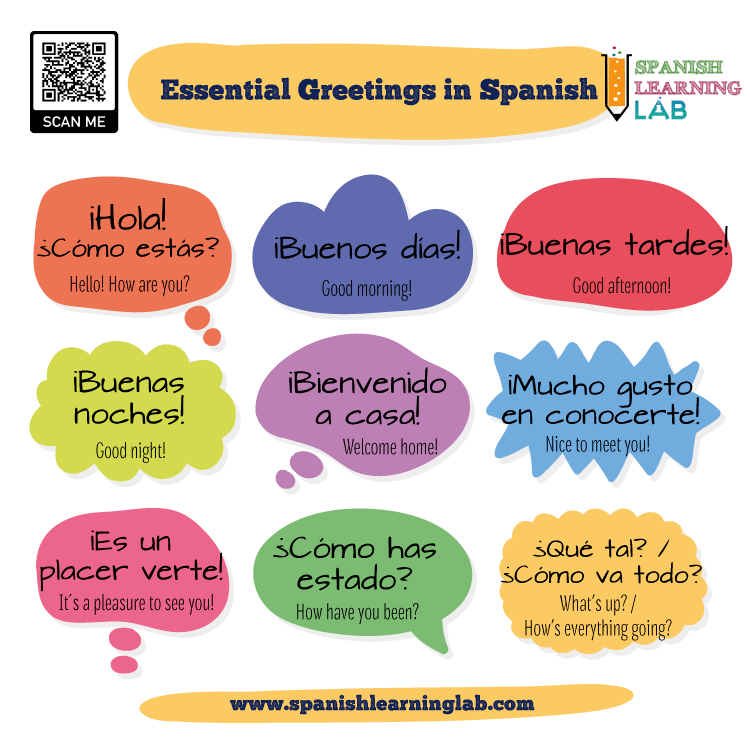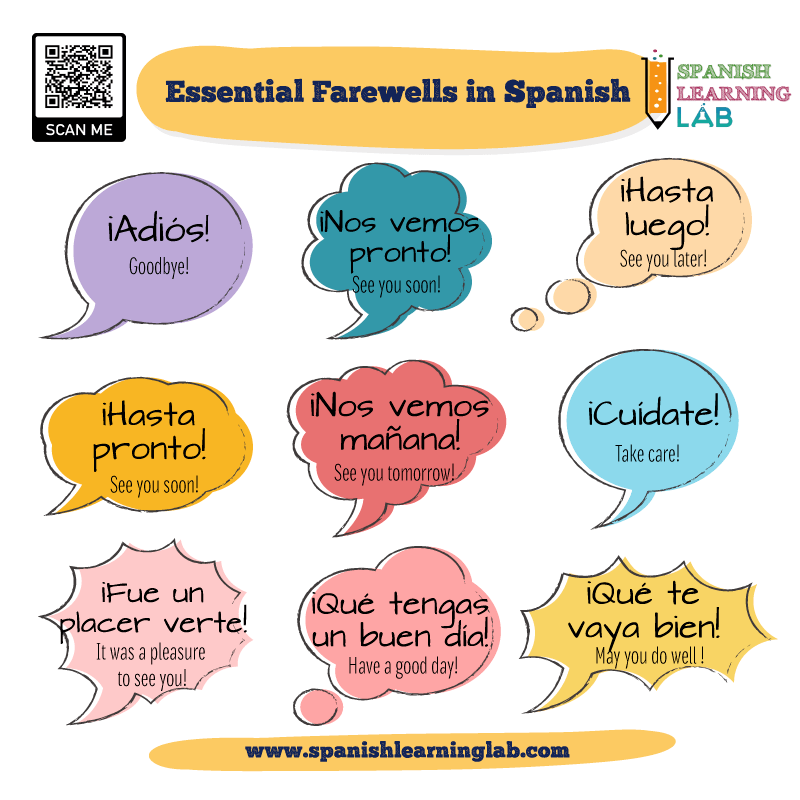Spanish greetings and farewells are part of the vocabulary that you will need in daily interactions. Using the right greeting (saludo) before getting into the main conversation is always a good sign of politeness, especially when introducing yourself or someone else in the language. In this lesson, you will learn how and when to use Spanish greetings to begin a conversation in the language, as well as how to choose the appropriate expressions to say goodbye depending on the situation. This lesson includes many examples, a video and quizzes to test the main key points in it. Let’s start…
Vocabulary introduction: Common Spanish greetings and farewells
As a warm-up activity, we will ask you to watch this short video on common greetings and farewells in Spanish. This video explains the most important things that you need to know about this lesson, including how to use and pronounce words like HOLA and BUENOS DÍAS, as well as when to use different ways to say goodbye. The last part of the video has two examples of simple conversations using Spanish greetings and farewells. Please activate the subtitles if you need them.
Basic Formal and Informal Spanish greetings: list + audio
There are two exclamation marks in Spanish…
The first thing you need to know about Spanish greetings, los saludos, is that we use two exclamation marks with different orientations when we write them, one at the beginning and another at the end of the sentence, e.g. ¡Hola! Some expressions like “¡Buenos días!” are only appropriate for morning time, whereas others like “¡Hola!” can be used at any time of the day. Here is the first short list of basic greetings and some other words you need to know about this topic. Click on PLAY to listen to the examples.
|
Primero tenemos que saludar a los invitados
First we have to greet the guests.
|
|
¡Hola! ¿Estás ocupado?
Hello! Are you busy?
|
|
¡Buenos días Sr. Tórrez! Siéntese por favor.
Good morning Mr. Torrez. Please sit down.
|
|
¡Buenas tardes Sra. González! Lamento llegar tarde.
Good afternoon Mrs. Gonzalez! I am sorry I am late.
|
|
¡Buenas noches! Estamos contentos de verte
Good evening/night! We are glad to see you
|
Ways to say and respond to “how are you” in Spanish
There are different ways of saying “how are you” in Spanish. ¿Cómo estás? is perhaps the easiest to remember. To ask formally, you can use ¿Cómo está usted? and also ¿Cómo ha estado?. The answer might vary from country to country, but a very simple “Bien ¿y tú?” would be fine anywhere. Listen to different ways to say and respond to “how are you” in Spanish in the chart below:
|
¿Cómo estás (tú)? – (Yo) estoy bien, ¿y tú?
How are you? – I am fine, and you?
|
|
Hola Xander. ¿Cómo has estado? – Me encuentro bien, gracias
Hi Ken. How are you doing? – I am doing well, thanks
|
|
¿Cómo van las cosas Carlos?
How are things going Carlos?
|

Spanish greetings for “Nice to meet you” and others
When you meet someone for the first time, you can use the equivalent expression for “Nice to meet you” in Spanish, that is ¡Mucho gusto! or ¡Mucho gusto en conocerte! (CONOCER is translated as “to know” into Spanish). If you have already met that person, then just change CONOCERTE to VERTE, for example ¡Mucho gusto en verte!. In both phrases, the preposition EN is optional. Listen to some examples using ¡Mucho gusto! and similar Spanish greetings.
|
¡Mucho gusto en conocerte Roberto!
Nice to meet you Roberto!
|
|
¡Es un placer conocerte!
It is a pleasure to meet you!
|
|
¡Qué gusto verte Sandra! – ¡Qué gusto verte también!
Nice to see you Sandra! – Nice to see you too
|
|
Es bueno verte.
It is good to see you
|
|
¿Qué pasó?/ ¿Qué hay?/¿Qué nota? – this questions varies from one country to another.
What´s up?
|
To respond to a greeting, we often repeat the same expressions (except with “Hola”) and add the word TAMBIÉN(too) at the end or at the beginning, for example:
Alice: ¡Mucho gusto! / ¡Es un placer!
Juan: ¡Mucho gusto también! / ¡También es un placer!
Basic Spanish farewells: examples and pronunciation
Saying goodbye in Spanish
There are many ways to say goodbye in Spanish, “formas de decir adiós”. Using one expression or the other depends on the formality of the conversation and the time you have spent with the other person. Spanish farewells also need two exclamation marks when written. Both ¡Adiós! and ¡Nos vemos! are very common forms to say goodbye. ¡Nos vemos! is a form to say that we will see each other again. You might add a time clause like PRONTO (soon), MAÑANA (tomorrow), LUEGO (later), EN UN MOMENTO (in a moment) after NOS VEMOS as a way to clarify when you will meet the other person.
|
¡Adiós Roger! Te veo mañana en la escuela
Goodbye Roger! See you tomorrow at school.
|
|
¡Adiós Ariana! ¡Nos vemos!
Goodbye Ariana! See you!
|
|
Es tiempo de irme. ¡Adiós!
It is time to go. Bye!
|
|
Bien, ¡nos vemos pronto! ¡La pasé muy bien!
Well, see you soon! I had a good time here.
|
|
¡Nos vemos pronto entonces! ¡Por favor cuídate!
See you soon then! Please take care!
|

Saying “See you soon” in Spanish
Perhaps you have noticed that we have been using the word VEMOS. It comes from the verb VER (to see) and it is normally used in Spanish farewells meaning “See you!”. In the expression ¡Nos vemos! we can replace NOS for TE when we are referring to one person or to LOS when we are referring to several people, for example: ¡Te veo pronto! and ¡Los veo pronto!
Another important phrase for “See you soon” in Spanish is ¡Hasta luego! and this is easy because we do not need any pronoun or verb. You should simply follow the structure: ¡Hasta + TIME! as in ¡Hasta pronto!, ¡Hasta luego!, ¡Hasta mañana! and so on. There are some more complex expressions, but if you can remember ¡Adiós!, ¡Nos vemos! and ¡Hasta pronto!, you will do fine in most conversations.
|
Lo siento, tengo algo que hacer. ¡Te veo luego!
Sorry, I have something to do. See you later!
|
|
¡Hasta luego! ¡Qué te vaya bien!
See you later! May you do well!
|
|
Discúlpeme pero debo irme ya. Fue bueno verlo.
Excuse me, I must go now. It was good to see you.
|
|
¡Qué tengan una buena noche! / ¡Pasen buenas noches!
Have a good evening/night!
|
Listening Activity: Saying hello and goodbye in Spanish
Communicating: Using the vocabulary in this lesson and the previous one, make up a simple conversation to introduce yourself in Spanish. Use as many expressions as possible. We really hope you enjoyed learning about this topic. ¡Hasta pronto!
Spanish introductions and greetings PDF Worksheets
- Getting to Know People in Spanish: PDF Worksheet
- Talking about Yourself in Spanish: PDF Worksheet
- Practicing Spanish Introductions – PDF Worksheet
